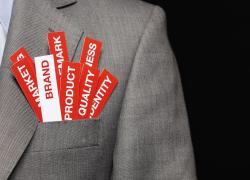People love free stuff.
It’s true!
I always say, “food tastes better when it’s free.” The only time you’ll catch me with deep dish pizza, fancy fruit juice, or salad with watermelon in my hands is when I’m sampling - because normally, I hate those products, but the word “free” changes all of that.
Obviously, for consumers, free samples are so worth it, but how about for businesses?
Is providing free samples a good marketing strategy?
When determining whether your brand should launch a campaign to sample your products or services, it’s important to consider:
But first, let’s start on a positive note, because there are many, many pros to sampling.
Pros

1: Get prospects familiar with your brand
It’s a really easy way to get new people to try your product and potentially expand your customer base.
Then, once people get acquainted with your product, there’s a higher likelihood that they’ll purchase your brand over another due to familiarity and loyalty.
When it comes to complicated products, sometimes, words don’t suffice.
People need a hands-on experience with your product to understand its full value; therefore, it’s easier to spend a little extra money to allow people to try your complex product than to miss out on potential sales.
This also benefits services, as prospects are more likely to buy a software they have already familiarized themselves with through a free trial. It gives customers a chance to get used to the product or service, test it out themselves, and keep your brand in consideration when purchasing.
2: No price barrier
This is especially valuable for bulk products. If you’re unsure of how much you like the taste of something, you’re not going to buy a huge box to find out, right?
Samples take away the hesitation of having to spend money to try something new. This pro is a win-win: companies gain new, satisfied customers, and consumers get to try something new without the financial burden.
3: Cheaper than other forms of marketing
Traditional advertising is more expensive and arguably less effective.
People don’t like to be sold to without receiving some value in return, so providing a sample in exchange for the hopes - but not guarantee - of gaining a new, loyal customer is still more effective than outbound marketing.
At least this kind of marketing is an investment in loyalty, not just exposure.
4: Psychologically, it’s very effective
First of all, receiving a freebie typically creates a subconscious need to reciprocate the favor, which generally results in purchasing from the brand that gave the sample.
This is referred to as the reciprocity principle, and it surprisingly happens regardless of whether the consumer asked for a favor or not.
This means that, after handing (or mailing, or even emailing) out an offer, many people feel an obligation to pay the brand back for their generosity.
Also, sampling increases customer loyalty.
Not only does it nurture buying habits, where the consumer will be more likely to come back and buy that brand over another if satisfied, but it also pays off in increasing your brand’s customer base.
Obtaining a new customer is much harder than keeping an old one on board, so if a sample helps your brand gain a new fan, that’s a small but important win.
Sampling also is perceived as being generous, which is a good reputation for a brand to build upon. Customers tend to reward brands’ generosity by paying more for products or services. They also buy more to upgrade - they’ve tried a little bit, liked it, and now they want a lot.
The final psychological effect is the perception of value of freebies.
While having a standalone, cheaply-priced product lowers buyers’ impression of it, adding a free item to a high-value purchase actually has the opposite effect. Lumping something in with an expensive and high-quality product rubs off positively on the perception of the freebie, making the purchase seem more worthwhile than without the free item.
5: mystery sells
Curiosity killed the cat...but also drives online sales for many beauty brands.
The trick?
Throw in a small, free, and unidentified gift to large purchases, and people will need to purchase in order to get a little pizzazz in their life and solve the mystery that’s gnawing at them.
Who doesn’t love a good surprise?
Known offers actually perform worse than surprise freebies, probably because of the effectiveness of how fun it is to get something mysterious and unexpected as a gift.
6: You GET free W.O.M.M.
Word of mouth marketing is usually planned, paid for, and executed in order to spread the word, but it also has a compounding effect on samples.
Humans are social beings: something cool happens; they can’t wait to tell someone.
Naturally, then, people take to social media to boast about their positive experience with a brand - especially when they pay $0 and receive something in return.
While your brand does have to pay for the products or services being sampled by consumers, their resulting publicity is totally free. Win-win.
7: Great for collecting feedback or testing new products
The best way to find out how well your product or service will perform on the market is to give it to real, live people, let them tinker with it, and then ask for their opinion.
When handed something completely free, most consumers will feel it’s fair - or obligatory, even - to provide constructive criticism in exchange. It’s the least they can do, after all.
Before you put in a serious amount of resources to launch, promote, and convince prospects of your latest innovation, get some samples out there to get a feel for the success of the product.
It’s the best way to test new ideas without the risk of massive and public failure.
8: Cleans out your inventory efficiently
Have a lot of stuff in your inventory that’s just not selling fast enough?
Give out samples - that way, at least, the product is getting used up instead of going bad, and if you’re lucky, it may reignite interest in the product and help sell off the rest.
At the very least, your brand will be perceived as more generous in consumers’ eyes, which will increase the reputation of your brand, help it gain more customer loyalty, and ultimately, make you more money.
9: Boosts sales
This is a very straightforward reason to believe in free samples. While it costs money to give out samples, it turns out that it makes a whole lot more dough in return.
The average sales boost that brands receive from sampling campaigns ranges between 71-600%!
Unfortunately, none of the above pros are entirely guaranteed; it all depends on the specific circumstance, the consumers, and more. So, before you take all the good news and run with it, it’s important to recognize the pitfalls of this strategy as well.
Cons
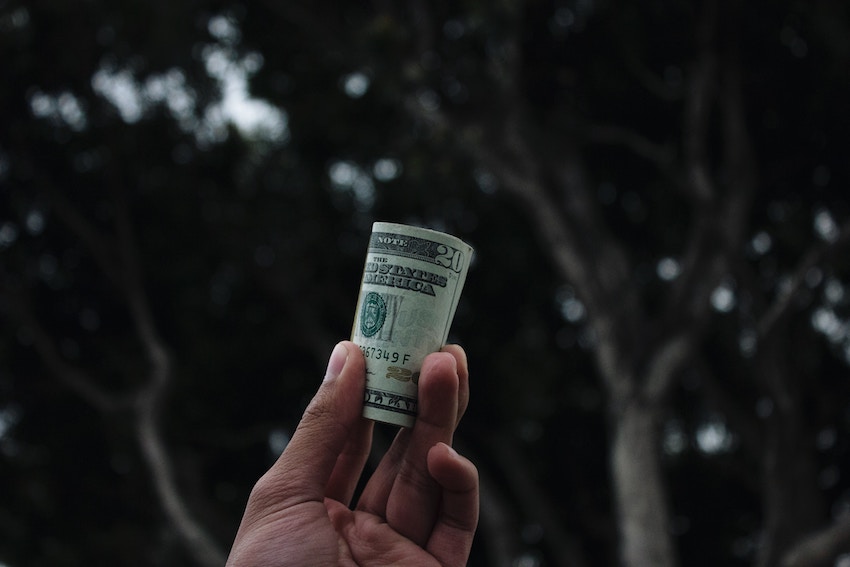
1: There are no guarantees
As with all marketing campaigns, you cannot put in a certain amount of resources to expect an exact return - there are too many moving parts for any kind of guarantee.
That means that launching a sampling campaign can be super effective, or it could prove to be a total waste of money, but that’s just part of it.
There is no way of knowing for certain whether the ends will justify the means.
Part of the risk, too, lies in the growing number of freebie hunters these days: some people just want free stuff and then leave, never looking back once. Those people take from you and don’t feel the need to give back, which makes them a poor investment as a customer.
Even so, for non-product and non-brick-and-mortar businesses, there is hope: specific prospect targeting and action-triggered freebies are more efficient and allow you to choose who you reward with free stuff instead of casting a wide net.
2: It costs money
Nothing is free, especially exposure.
Sampling is an investment of your brand’s products or services, time, and labor, and you can only hope that it will be worth the price.
Huge brands spend billions on sampling campaigns, but for small businesses, that’s probably not feasible at all.
Decrease the financial risk by allocating a safe amount of money and launching a sampling campaign with a clear objective.
3: Some people wait around for the free stuff
Idle customers can be inspired to make a purchase with free incentives, but some of those people do almost all the actions necessary on purpose - when consumers know that a brand will send them a routine, free item to incentivize a purchase, they may just collect their prize and go back into hiding until the next gift comes along.
Worse yet are the people who figure out the email flow, “rig” the system and abandon their cart to trigger an action, then wait for a reward, rinse, and repeat.
4: Traditional sampling is not very controllable
If you have a table set up in a grocery store, you can’t expect every person who grabs a sample to take note of the brand, ask some questions, then go purchase. As soon as the prospect walks away from the physical table, you lose touch with them.
Furthermore, it’s hard to attract new people if you’re sampling within your store or somewhere that doesn’t capture the attention of totally new customers and allow for brand discovery.
Luckily, digital sampling campaigns cover many of those issues, as customers can be targeted online based on being a good match, then their actions can be tracked and purchases recorded and properly attributed to being post-sample.
5: Some things just aren’t easily samplable
It can be tough to sample an expensive, large, or otherwise complicated product.
You certainly don’t want to be in the awkward position of giving your whole product away for free, leaving nothing to incentivize the customer to spend money.
Some brands give out freebies associated with their brand that are not actually for sale.
Banks really like to hand out frisbees, hand sanitizer, and other small items that are essentially irrelevant to the business of securely storing money.
Though this isn’t actually a form of sampling their product, it’s a great way to add presence marketing (a form of guerrilla marketing) to your overall strategy.
6: The ecommerce dilemma
With an ecommerce business, there are many more considerations than with a traditional sampling strategy.
First, do you set up a physical sample station, do a campaign online, or just randomly select customers to receive freebies?
How do you select who is the best investment for sending a sample to?
Do you send multiple samples to average consumers, or invest in reaching an influencer who can further advocate for your brand?
It takes a lot more planning and deciding when launching a sample campaign for an ecommerce business.
On the plus side, however, these businesses have a lot more flexibility in execution and higher capabilities of tracking the conversions resulting from samples.
7: Vendor coordination
For traditional sampling, oftentimes, the product being sampled is carried in a store of many brands, such as a grocery store.
In that case, the brand providing the samples must coordinate their efforts with the vendor’s to make the most out of the campaign.
Some factors that must be considered include:
- Traffic capacity - how many people can actually fit around the space
- Retailer support - how much help you’ll get on the ground
- Control over equipment - trusting others with your stuff, especially if you store a table with them
- Disruptiveness - you want to attract attention, but you cannot disrupt the shopping experience at the same time
On average, sampling campaigns pay off. If you don’t believe me, let the data speak for itself.
ROI
![]()
Based on a report from Sampling Effectiveness Advisors…
- Only 19% of consumers could be swayed by a TV ad to make a purchase
- The average increase in conversion rates for companies that launched sampling campaigns was 32%
Opinion Research Corporation found…
- 81% of consumers are more likely to try a product after receiving a free sample
As an industry-specific example, Euromonitor International reports that…
- “Free samples” is the fourth biggest influencer for purchasing beauty products
A Nielsen study determined the factors of a purchase that could sway consumers, too.
This kind of information is important in determining which aspect of your product is better than the competitors’ in order to leverage that element as a selling point.
Most importantly:
- 47% of consumers can be swayed on the price factor
- 20% of consumers are willing to switch brands if they perceive the quality of the competitor’s product to be better than their existing choice’s quality
The data on how much money a company can earn post-samples is lacking, primarily because every brand’s situation, scale, objectives, and results are different, but also because it may be hard to track for certain operations.
For digital sampling via free trial, however, it’s a little easier to find the exact conversion rate of customers due to the collected information during the trial period. Let’s use a wildly successful example: Netflix.
Merriman Capital analyst Eric Wold has been tracking Netflix’s trial-to-membership conversion rates for years, and he discovered that the company really is good at enticing people to join. Their conversion rate is 93%, which is pretty darn high.
Let’s compare a few membership-based businesses side-by-side:
- CallWave converts from free trial with credit card to paid membership at a rate of 45-55%
- Evernote converts from a free trial to a premium version at around 3%
- Netlix takes the cake with a conversion rate of 93% from free trial to paid subscription
The ROI of a sample campaign really depends on the objectives and approach.
Deciding whether to do a traditional sampling campaign versus a mail-out one will yield different results based on your target market’s preferences.
Digital campaigns can vastly vary, too: individually selected free samples or general public freebie, free trial or limited demo, initial signup with or without credit card information, upgrade to premium or select a different level plan, and so on, and so forth.
One thing is for certain, however: there are real-world examples out there that can teach us a lesson in what to do...as well as what not to do.
Case Studies
Win: Birchbox
This subscription box company that delivers hand-picked beauty products was founded in 2010 and has seen a lot of success since launch.
Their secret?
They run on samples, at least initially, then get subscribers hooked enough to pay for the big stuff.
For $120 a year, subscribers pay to receive monthly product samples from 500 brands.

Not only did Birchbox get in on the subscription-based trend just in time, but they discovered the benefit of partnering with the brands that then get to profit from Birchbox sending out their samples to their customers.
Of 40,000 subscribers, 50% make full-size product purchases on Birchbox’s site.
This means that half of the people who receive product samples in the mail from this brand benefit enough from the product - and have enough confidence from testing it out - to make a full purchase, which is where the real profits come in.
The lesson here: people will actually pay money to get the opportunity to regularly and easily sample a wide variety of products that are selected for them.
Furthermore, having a business that deals primarily with subscription-based samples allows for consumers to confidently make larger purchases after getting a chance to test out the products first.
Remember the element of surprise from the pros section? People love receiving an always-changing variety gift box in the mail because it’s something fun to look forward to every month.
Fail: Sunny Co
The Arizona-based online swimwear company launched a promo back in May that nearly broke Instagram.
While that may sound epic, it actually caused a lot of ruckus for the business, primarily because of the lack of limitations the team imposed on their free sample campaign.
The brand posted an image on Instagram in early May, asking followers to repost the image and tag the company within 24 hours, and receive their Pamela swimsuit (pictured) for only the price of shipping and handling.
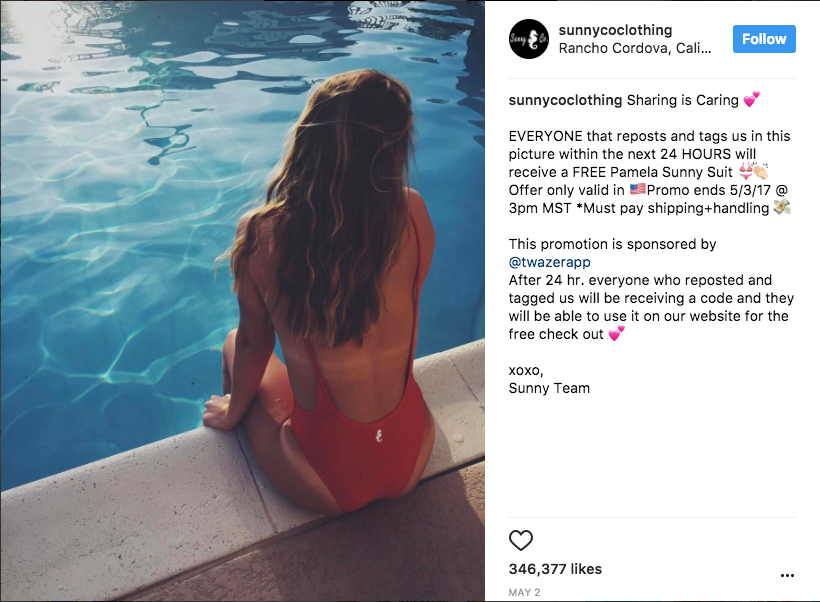
The suit was originally priced at $64.99 and was being offered for $12.98, an offer that at least 334,000 people liked - literally.
The post blew up, everyone’s Instagram feeds bled red for a day with the viral reposting of the Pamela swimsuit photo, and Sunny Co started to worry.
They posted a second image with a long list of rules, including the right to cap the promotion when they see fit - something the company failed to address the first time around, likely costing them a lot of money and reputation points.
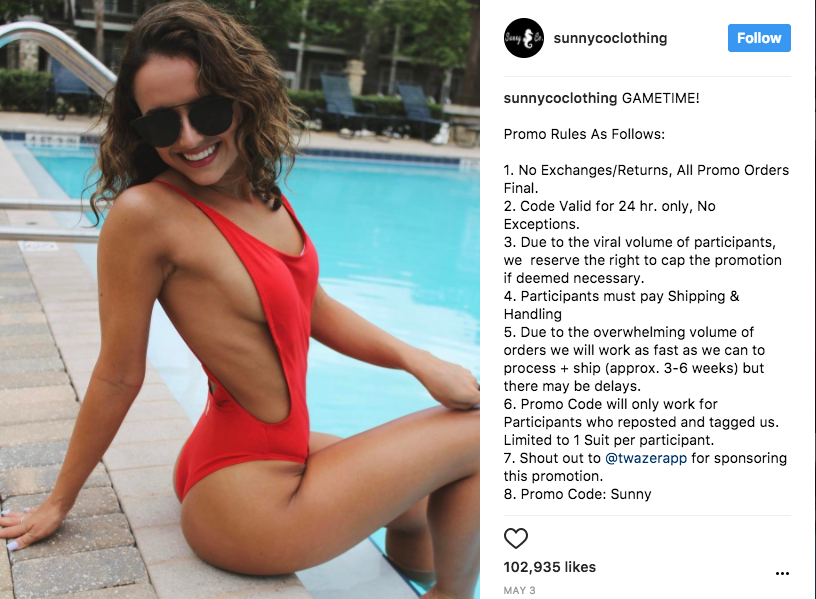
When the orders flooded in, Sunny Co was overloaded with over 50,000 emails on their site, including angry questions regarding non-functioning coupon codes, the fact that the Pamela suit was marked as “sold out” so quickly, and others wondering if the whole thing was a scam.
After 6 weeks, the company had finally caught up to the deluge of orders and thought that it was all over. Unfortunately for them, the internet holds grudges and likes to joke about the past...a lot.
Now, the business did profit $6 per suit sold and gained 700,000 followers on Instagram, but it also left a bad taste in a lot of consumers’ mouths due to the failure to grant their offer to everyone who followed the rules to a T.
The lesson here: if you’re going to do a huge giveaway, clearly map out your campaign, set reasonable limits based on your inventory capacity, get ready for an influx in purchase orders, and stay in control of the campaign the entire time.
Going viral can be good, but not when it’s because your business is being ridiculed for its failure to live up to expectations.
Win: Costco
Finally, let’s talk about the champion of creating the right ambience for shopping and eating. Costco is famous for its free samples, and they want it to be that way.
It helps establish the store as a fun place to be - some people have even taken dates there - and draws in more people because of it.
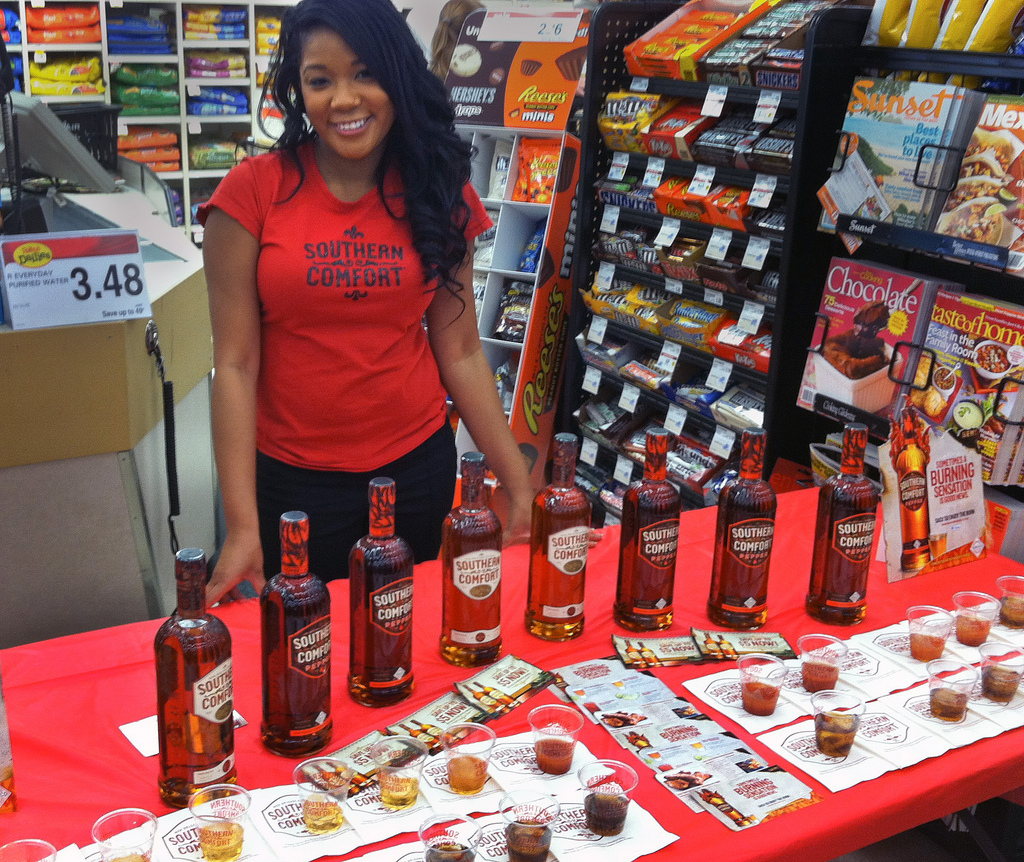
When it’s hot and the A/C is broken, people go to Costco. When they want cheap hot dogs or pizza, they go to Costco. Free lunch consisting of a variety of free samples? Costco is the first place that comes to mind.
You’d think that the brand loses money on how much they give away, but it’s on the contrary: the campaign results from brands that provide samples include…
- A 71% increase in beer brand sales
- A 600% increase in frozen pizza sales - and all purchases were post-sample!
- At least a 300% increase in wine sales
- Cosmetics increase of more than 500%
- Packaged cheeses doubled in sales
Why does it work so well? Samples reignite cravings - you can’t just have a single bite of chocolate without wanting more...well, at least I can’t.
Costco is well aware, and provides samples of foods that people may have forgotten about, have been apprehensive to try, or just normally wouldn’t think to purchase when not craving. This ultimately leads to impulse buys and more money for the business.
Just look at Costco’s numbers - free samples really work.
The Bottom Line
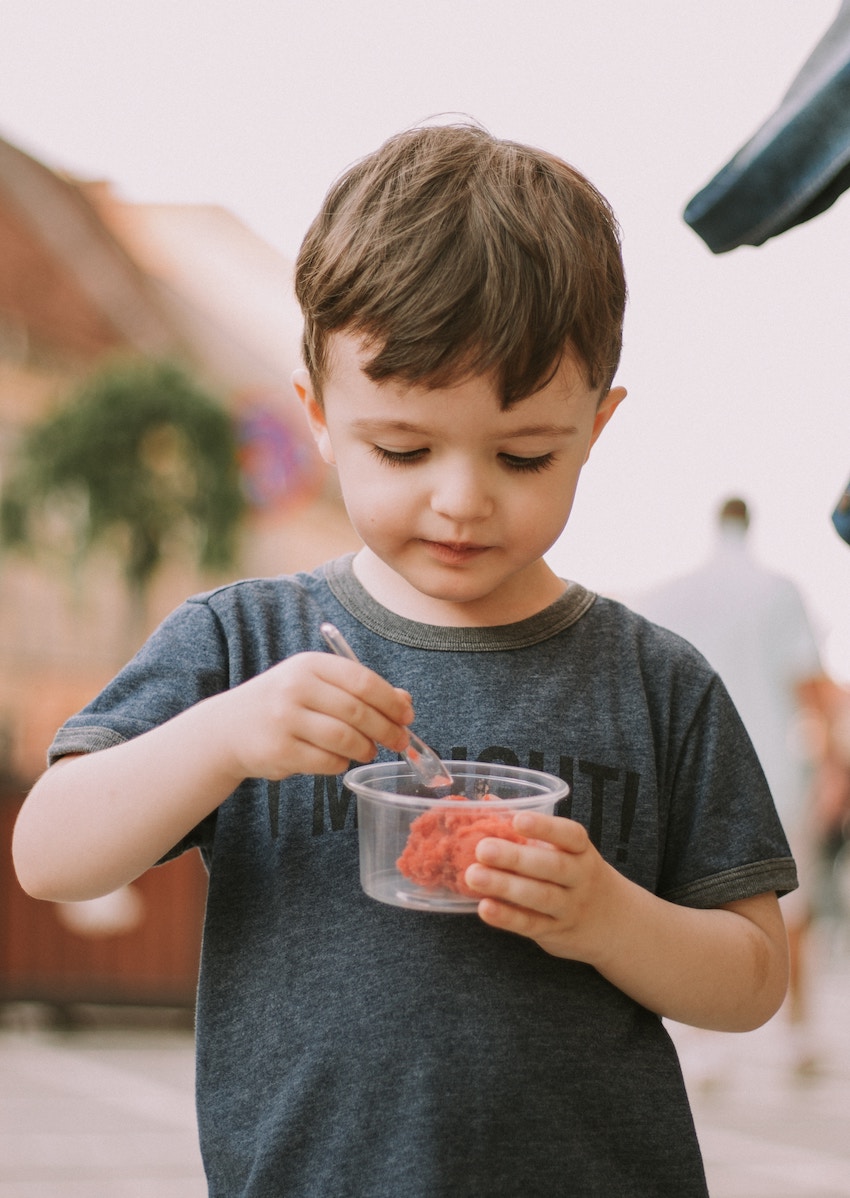
While a sampling campaign does carry risk and requires a lot of planning, it truly is the best way to get your product or service seen, tested, familiarized, and sold.
It’s a win-win for everyone: people who love free stuff get their wish granted, and businesses rack up more sales and, ideally, more long-term customers.
Has your business launched a sampling campaign before? Are you considering one in the future? I’d love to hear your thoughts below!




